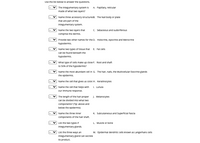


The integumentary system refers to the body's organ system comprised of skin nails and hairs, and exocrine glands. This system helps in protecting the body from any microorganisms and chemicals as well as environmental factors.
The integumentary system is made up of epidermis and dermis layers.
The three structures that are part of theintegumentary system include hair, nails, and multicellular exocrine glands.
The two layers that comprise the dermis include the papillary dermis, and one is the reticular dermis.
The two other names for the hypodermis are subcutaneous tissue and superficial fascia.
The two issues that can be found beneath the hypodermis are muscle and bones.
The type of cell making up close to 50% of hypodermis is adipocytes called fat cells.
The most abundant cell in the epidermis is keratinocytes. They act as an immunomodulator.
The cells which are responsible for providing us the colors are melanocytes. They are composed of the pigment melanin, which determines the color.
The cells that help us with immune response epidermic dendritic cells, also called Langerhans cells are antigen-presenting cells.
The length of the hair proper can be divided into two components includes root and shaft.
The three inner components of hair shafts include a soft medulla (a central portion), a hard cortex, and a cuticle.
The two types of integumentary glands are sebaceous glands and sudoriferous glands. These are oil and sweat producing glands.
The three ways an integumentary gland can secrete its product are Holocrine, apocrine, and merocrine. These are exocrine glands.
The portion of nails is visible that covers the epidermis or the nail band is the nail plate and body.
The crescent-shaped whitish area of the plate cuticle of the fingernail is lunula.
The nail plate's anterior margin extends beyond the digit is called a free nail edge or margin
Step by stepSolved in 3 steps

- Paper cuts are often very painful but don't always bleed. What two properties of the skin explain this combination? A. the dermis is innervated, but the epidermis is not B. the epidermis is innervated C. the epidermis is avascular D. paper cuts only go as deep as the reticular dermis E. the epidermis and papillary dermis are avasculararrow_forwardYou are looking at a slide from a patients sole. Which of the following layers of the epidermis would be present in the sample from your patient's sole, but not if you had taken a sample from the skin at their ankle? : Stratum corneum Stratum basale Stratum lucidum Stratum papillum In the "ABCD" rule used while diagnosing melanoma, B stands for: : behavior of the lesion blueness of the lesion border of the lesion blood vessels in the lesionarrow_forwardUse the list below to determine the correct terms. Keratinocytes start producing A. Shaft ,which makes our skin tough and water resistant, and ,which promotes the dehydration of skin cells. The reticular layer within our B. Hair bulb, hair papilla ,contains a network of collagen, reticular, and elastic fibers. The hypodermis, because of its c. Arrector Pili. large amount of acts as an energy reservoir and thermal insulation. The _is the part of the D. Keratin, Keratohyalin hair that protrudes from the epidermis. The deepest portion of the hair E. Dermis follicle is made of ,the inner portion of this structure encompasses the The papilla's surrounding layer isF. Nail root composed of thearrow_forward
 Human Anatomy & Physiology (11th Edition)Anatomy and PhysiologyISBN:9780134580999Author:Elaine N. Marieb, Katja N. HoehnPublisher:PEARSON
Human Anatomy & Physiology (11th Edition)Anatomy and PhysiologyISBN:9780134580999Author:Elaine N. Marieb, Katja N. HoehnPublisher:PEARSON Anatomy & PhysiologyAnatomy and PhysiologyISBN:9781259398629Author:McKinley, Michael P., O'loughlin, Valerie Dean, Bidle, Theresa StouterPublisher:Mcgraw Hill Education,
Anatomy & PhysiologyAnatomy and PhysiologyISBN:9781259398629Author:McKinley, Michael P., O'loughlin, Valerie Dean, Bidle, Theresa StouterPublisher:Mcgraw Hill Education, Human AnatomyAnatomy and PhysiologyISBN:9780135168059Author:Marieb, Elaine Nicpon, Brady, Patricia, Mallatt, JonPublisher:Pearson Education, Inc.,
Human AnatomyAnatomy and PhysiologyISBN:9780135168059Author:Marieb, Elaine Nicpon, Brady, Patricia, Mallatt, JonPublisher:Pearson Education, Inc., Anatomy & Physiology: An Integrative ApproachAnatomy and PhysiologyISBN:9780078024283Author:Michael McKinley Dr., Valerie O'Loughlin, Theresa BidlePublisher:McGraw-Hill Education
Anatomy & Physiology: An Integrative ApproachAnatomy and PhysiologyISBN:9780078024283Author:Michael McKinley Dr., Valerie O'Loughlin, Theresa BidlePublisher:McGraw-Hill Education Human Anatomy & Physiology (Marieb, Human Anatomy...Anatomy and PhysiologyISBN:9780321927040Author:Elaine N. Marieb, Katja HoehnPublisher:PEARSON
Human Anatomy & Physiology (Marieb, Human Anatomy...Anatomy and PhysiologyISBN:9780321927040Author:Elaine N. Marieb, Katja HoehnPublisher:PEARSON




